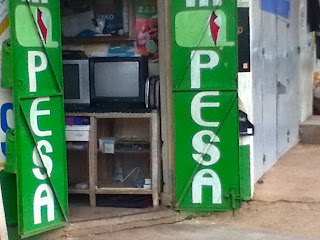Everywhere I go, mostly in small to medium sized towns and villages, you will notice the words M-PESA splattered on so many walls and signs at many shops all over. Looking at the pictures below, can you tell me how many M-PESA words can you find. Note: You can click on the picture to enlarge them. From four pictures below, I found 20 M-PESA words. Agree or disagree?
So, whats with the M-PESA? M-PESA stands for Mobile Pesa, and Pesa is Swahili word for money, so in other words is mobile money or mobile wallet. So hows that mobile? They live in your phones instead of your wallets.
I read somewhere that its like 1 out of every 3 Kenyans have a phone. I think I agree based on what I have observed but I think maybe its gaining ground to where maybe its more like 1 out of every 2 Kenyans got a phone.
Furthermore, currency is often hard to get -- for example when you are in a supermarket, you will often find cashiers trying to get currency from the next cashier or ask you for other bill or coin amounts so that they can change your total successfully. Can you imagine same situation for even smaller shops and open-air markets, or even for Maasai tribe out in the open safari trying to buy or sell their livestock and not able to carry cash.
Although I have not yet used my VISA but I have seen other volunteers trying to use their VISA at places, even at a large supermarket, they will find it a challenge to have them accept the card. Some places will require you to head over to their customer service desk and do the VISA transaction there (the manual way I assume) as I have not yet seen any places with VISA card readers. I assume its probably easier to use VISA in Nairobi, the capital, and Mombasa (the beach city).
M-PESA was brought to Kenya by its largest cell carrier -- Safaricom. People can go to any Safaricom agents to load money into your phone M-PESA account. First timers will need to apply and show Kenyan national ID or a passport, but after that, you can go to any of them to load (or withdraw) cash into your phones. No need to go to banks or branches and wait in line for your financial transactions.
Once you have a balance on your M-PESA, you simply go to any shops or even to individuals, and pay by using your phone, sending an amount to the other person's phone number (along with safeguards like pin, etc). Once the other person phone receives a SMS confirming the transaction, your business is successfully done.
This method spread across Kenya and other surrounding countries like wildfire. I read somewhere that theres like 17 million M-PESA accounts are already floating around. There is like 38 million Kenyans, so thats like half of them got a M-PESA account already.
I will open my own M-PESA account once I get my "red book" (residency document) when I am sworn in as a Peace Corps Volunteer next month. So I do not have to carry too much cash in my wallet, and be an easy Mzunga (white foreigner) target.






















